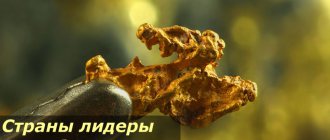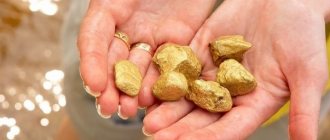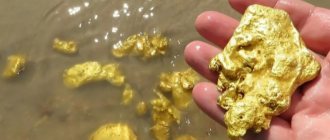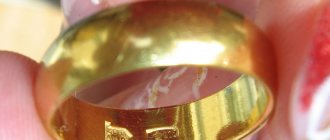Gold in antiquity
Archaeologists around the world still cannot say the year when gold was discovered . Scientists can only speculate about this period. The gold itself and jewelry were found in various places. For example, remnants of the valuable metal were discovered in caves inhabited by people 50,000 years ago. Scientists say that this precious material became most popular in China, India and Egypt. Moreover, most of them believe that the first who mined the first solar metal were the inhabitants of Egypt.
More than 4,000 years ago, the Egyptians became the first to establish gold mining and processing. However, at first the monetary unit in Egypt was barley, and only after some time did gold become equal to money.
By the 7th century before modern times, Egypt possessed more than 3,000 tons of gold, but during the war with the Assyrians it passed to them. About 50 years later it ended up in Babylon, where reserves were increased to 5,000 tons. Egyptian gold began to move from state to state, and its mining was practically stopped.
Emergence of the gold standard
The gold standard is a financial system in which the value of money is expressed in a certain amount of gold. This system replaced the silver standard. In addition, along with gold, there is also a bimetallic standard, which shows the ratio of gold to silver. The main rule of the gold standard was the right to quickly and easily exchange paper money for gold. Thanks to this, financial market inflation would disappear.
The owner of this bill had gold equivalent to one hundred dollars.
The first mention of this system dates back to 1821 in England. That is why the pound remained the world currency until 1914. During the Bretton Woods Conference, the gold standard was legalized. The United States abandoned the gold standard system in 1971, and the system has not been used since the Jamaica Conference.
Due to the current crises, economic experts have often raised the issue of returning to the gold standard. But the amount of precious metal is too small to fully ensure the circulation of money. The main advantages of choosing gold as a universal currency were:
- durability, the invariability of its properties over time;
- high price;
- good divisibility;
- ability to identify all noble metals.
The reasons why people began to abandon the use of gold as currency:
- impossibility of quick and easy emission;
- heavy transportation of large amounts;
- loss of gold.
There were three types of gold standard:
- Gold coin standard. The classic gold standard, which was observed in countries that used coins made of gold, as well as paper money. Any type of money could be exchanged for an equivalent in the form of gold in any form.
- Gold bullion standard. Due to the discrepancy between the amount of gold and the total mass of paper money, the gold coin standard disappeared. Therefore, it was established that money can only be exchanged for bullion (minimum weight 12.5 kg). Therefore, many poor people could not exchange their reserves for gold.
- Gold and exchange standard. This standard is also called the gold exchange standard. It takes into account all the nuances of the gold bullion standard in the current international situation. This standard was the basis of the Bretton Woods monetary system.
Middle Ages and modern times
After the collapse of Rome, all gold reserves were scattered throughout the world, which began to live on these jewels. For about 10 centuries, metal mining was practically not carried out and amounted to only about 3,000 kilograms per year.
By the end of the 15th century, people again began to look for gold deposits, as reserves were no longer sufficient. After the discovery of America, several thousand kilograms of solar metal were exported to European countries over the course of a quarter of a century, and over 200 years the weight of the transported precious metal amounted to more than 2,500,000 kilograms.
, many countries, including Russia, began to actively explore the discovery of gold In most cases, the discovery of new continents occurred thanks to this precious metal. Gold served as the beginning of the discovery and development of new lands and continents.
The most precious gift to humanity was kept in the South American Republic, where gold accumulations weighing more than 65,000 tons were found more than 100 years ago. Most of the solar metal has already been mined in South Africa, but still an average of about 500,000 kilograms of gold per year is still mined from this deposit.
A Brief History of Gold
It is believed that it was gold that brought all of humanity to a new level of development - the era of metals. Gold is a very rare and expensive metal, so it is not surprising that it began to be used as a means of payment. Archaeologists have found ancient gold items (dating back to 4600 BC) in Bulgaria in the Varna necropolis. This find is considered the oldest of all. Therefore, we can firmly state that humanity has been familiar with gold for many thousands of years.
This metal played an important role in the life of ancient peoples. In Egypt he was compared to the sun and unlimited power. All the country's wealth was stored in the form of gold. New currencies appeared and disappeared, but this expensive metal remained the same: universal and stable. Having a lot of gold was not only important and prestigious, but also quite dangerous. Egyptian gold has come a long way: first it was in the hands of the Assyrians, then the Persians, the Greeks and, finally, the Romans.
The history of gold dates back to the prehistoric era. Even then people understood all its value and importance.
Over time, many places where gold could be mined were discovered: in 1471 in Ghana, Mexico, Chile and Peru, in Brazil; in 1745 - in the Urals, in 1823 - in Canada and the USA; in 1851 gold began to be mined in Australia, and later in 1884 in South Africa. Thus, all countries gradually began to recognize gold as a common monetary equivalent. Many gold hunters appeared. In the 16th century, people mined a total of about 763 tons of this precious metal, in the 17th century - about 914 tons, in the 18th century - 18900 tons, and in the 19th century - more than 11616 tons.
Akinfiy Demidov, Russian gold miner
As for Russia, we started mining gold in 1726 (Demidovs). In addition, excavations were carried out at mines in Altai. Gold has been mined in Karelia since 1745. In the same 1745, the peasant Markov began mining gold in Berezovsky. In 1814, gold was also found in the Urals. After this, gold miners appeared in Siberia, Transbaikalia, near the Yenisei Ridge and in Kazakhstan. Then, at the end of the 19th century, gold deposits were found in the Far East. It was in Russia that industrial gold mining began using placers.
At all times, no other metal has given rise to so many crimes and wars. On the other hand, gold propelled the progress of mankind and brought it into a new era. The current monetary system was built on the basis of this metal. Today gold is a universal equivalent, a universal means of storage and payment.
Table element - gold
Aurum - gold - is one of the elements of the famous table of chemical elements, part of the group of metals. It is very resistant to various aggressive influences. Oxygen has absolutely no effect on this solar metal, so it does not oxidize. This metal is not exposed to various acids if the exposure occurs by one type. At a temperature of +25℃, the metal can dissolve in a mixture of nitric and sulfuric acid. Gold is also quite susceptible to the action of iodine and potassium salt.
Chemical features
Gold has several oxidation states: +1, +3, -1. The +5 indicator appears with fluorine, the compound with which acts as a strong oxidizing agent.
Because the element is relatively inert, it usually does not dissolve in acids. Therefore, it can be purified from impurities with these compounds. However, there are a few exceptions: gold can dissolve in selenic and hydrocyanic acids, cyanides, and also in aqua regia.
Under natural conditions, metal does not oxidize under the influence of oxygen. This is one of the reasons why it is considered precious. At high temperatures, the substance interacts with halogens (iodine, bromine and chlorine).
The most stable oxidation state is +3. With singly charged anions, gold forms planar-square complexes. The +1 oxidation state is considered relatively stable. The +2 indicator is usually expressed formally, but with it, half of the metal in the substance is oxidized to +1, and the other to +3. In aurides, the oxidation state of Au is -1.
Gold can react with perchloric acid at room temperature to form unstable chlorine oxides; it interacts with oxygen and other oxidizing agents as complexing agents: dissolving in cyanides, the element forms cyanoaurates.
Healing properties
Even in ancient times, people were convinced that solar metal had healing properties.
- Affects the human nervous system.
- Relieves inflammatory processes.
- Relieves allergic reactions.
- Increases brain activity and endurance.
- Improves memory.
- Improves mood.
- Protects from the evil eye and evil slander.
- Eliminates stress.
Moreover, to get rid of ailments, it is enough to simply wear gold jewelry constantly. Even ancient people believed that gold perfectly prolongs the life of its owner.
Modern view of the situation
There are plenty of useful elements in the earth's crust, but most of the gold is in the core. For this reason, scientists have wondered what influenced the process of formation of precious metal deposits.
There is a theory that metal appeared on our planet, like dust, it simply settled on the surface of the earth for years. In those years, our planet was in a molten state, this happened after an explosion. The Earth itself attracted cosmic dust, which contained Au.
In space, dust with a high concentration of noble metals was formed during the destruction of neutron stars. These are peculiar cosmic bodies that arose during the evolution of stars. Since dust is present everywhere, this explains why gold is found in humans, animals, plants, water and soil.
But there is one caveat: scientists were able to establish that a certain amount of Au is contained in asteroids and meteorites. But it has not yet been possible to prove that the metal settled on the surface of the earth as dust. But researchers are not yet able to refute this theory.
But it's not just dust from destroyed neutron stars that contains the noble metal. Some of it appeared on the ground during heavy bombardment. This happened about four billion years ago. And as a result of the bombing, a large number of craters were formed on the Moon. So, asteroids fell on our planet and gradually mixed with the soil, they penetrated deeply into the rock and, breaking up into millions of particles, turned into deposits of noble metal.
If we talk about plausibility, then this theory can be considered the most realistic. It helps explain where metal came from on our planet and how it got there.
Au is present in large quantities in the core, but this metal is in a molten state. Its extraction is associated with certain difficulties, for this reason it is considered unprofitable. There is also Au in the waters of the world's oceans: if you add up the entire amount of the element that is present in water, you will get a very decent amount of gold. But so far people have not found a way to extract metal from water.
There is also Au in the earth's crust, but its content is low; the metal is mainly mined together with ore.
Nature and gold
Unfortunately, gold is not widely distributed on planet Earth, so it has a high value. In the outer earth's crust its content is approximately 4.3·10-7%, and in a liter of water its content is 4·10-9 grams. Also, a small amount of solar metal is present in the soil and feeds the plants.
The method of extracting gold is considered a very labor-intensive process, so at all times it had a fairly high price. Geologists say that gold is a lonely metal, because very often it is found in its pure form.
How do you get it?
The main methods for producing gold on an industrial scale complement each other - for example, concentrate can be purified from dense impurities by amalgamation.
Flushing
Washing (sizing) is an ancient method of extracting gold sand (size) from secondary deposits. Sand is washed away due to its density: less dense minerals are washed out with water, and the concentrate settles.
Large-scale gold mining is automated: instead of people, washing devices and excavators work. However, the principle of their operation has remained almost unchanged over the past 2000 years.
The concentrate is not pure gold. There are elements that are denser - they settle with sand at the bottom of the washing tank. For final cleaning, other methods, in particular chemical ones, are used.
Amalgamation
This method has also been known since antiquity, but was described in the 16th century. It is possible due to the property of mercury to form alloys (amalgams) with other metals without additional thermal or chemical effects. After getting rid of waste rock fragments, the chemical elements are mechanically separated.
Expert opinion
Vsevolod Kozlovsky
6 years in jewelry making. Knows everything about samples and can identify a fake in 12 seconds
Amalgamation is not used everywhere: in a number of countries (since 1988 - in Russia) the use of mercury is prohibited due to the deadly danger of this element to humans.
Cyanidation
The method of extracting a precious element from ore by cyanidation is based on the ability of gold to dissolve in hydrocyanic acid (hydrogen cyanide, HCN) and its salts. The ore is treated with a weak (0.03–0.3%) cyanide solution. The noble metal reacts before other chemical elements, and after the chemical reaction it precipitates from solution.
Banking sector
In ancient times, gold was used only for making jewelry. Further, it became an excellent means of saving and accumulating wealth. Those who knew how to get gold did not need to think about tomorrow. After all, the precious metal was quite expensive at all times.
Today, gold is widely used to make coins. But the precious metal does not enter monetary circulation. Coins or bullion are held in financial institutions as savings. Investing in precious metals is at the peak of popularity today. In this way, you can not only save money, but also increase it.
New in blogs
Where did gold come from on Earth?
Yellow metal, a simple chemical element with atomic number 79. The object of desire of people at all times, a measure of value, a symbol of wealth and power.
How many human lives were destroyed for the sake of possessing this metal!? And how many more will be destroyed? Unlike iron or, for example, aluminum, there is very little gold on Earth. Throughout its history, humanity has mined as much gold as it mines iron in one day. But where did this metal come from on Earth?... It is believed that the Solar system was formed from the remnants of a supernova that exploded in ancient times. In the depths of that ancient star, a synthesis of chemical elements heavier than hydrogen and helium took place. But elements heavier than iron cannot be synthesized in the depths of stars, and therefore gold could not be formed as a result of thermonuclear reactions in stars. So, where did this metal even come from in the Universe?
It looks like astronomers can now answer this question. Gold cannot be born in the depths of stars. But it can be formed as a result of grandiose cosmic disasters, which scientists casually call gamma-ray bursts (GBs).
Astronomers closely observed one of these gamma-ray bursts. Observational data provide quite serious reasons to believe that this powerful burst of gamma radiation was produced by the collision of two neutron stars - the dead cores of stars that died in a supernova explosion. In addition, the unique glow that persisted at the site of the GW for several days indicates that a significant amount of heavy elements, including gold, was formed during this catastrophe.
“We estimate that the amount of gold produced and ejected into space during the merger of two neutron stars could be more than 10 lunar masses,” said study lead author Edo Berger of the Harvard-Smithsonian Center for Astrophysics (CfA) during a CfA press conference. in Cambridge, Massachusetts.
Neutron star merger
A gamma ray burst (GRB) is a burst of gamma rays from an extremely energetic explosion. Most GWs are found in very distant regions of the Universe. Berger and his colleagues studied the object GRB 130603B, located at a distance of 3.9 billion light years. This is one of the closest GWs seen to date.
There are two types of GWs - long and short, depending on how long the burst of gamma rays lasts. The duration of the GRB 130603B flare, recorded by NASA's Swift satellite, was less than two-tenths of a second.
Although the gamma-ray emission itself disappeared quickly, GRB 130603B continued to shine in infrared rays. The brightness and behavior of this light did not correspond to the typical afterglow that occurs when bombarded by accelerated particles of surrounding matter. GRB 130603B's glow behaved as if it came from decaying radioactive elements. Neutron-rich material ejected from neutron star collisions can become heavy radioactive elements. The radioactive decay of such elements produces infrared radiation characteristic of GRB 130603B. This is exactly what astronomers observed.
According to the group's calculations, the explosion ejected substances with a mass of about one hundredth of the Sun. And part of this substance was gold. Having roughly estimated the amount of gold formed during this GRB, and the number of such explosions that occurred throughout the history of the Universe, astronomers came to the assumption that all the gold in the Universe, including on Earth, may have been formed during such gamma-ray bursts .
Here is another interesting, but terribly controversial version:
As the Earth formed, molten iron flowed down to its center to make up its core, taking with it most of the planet's precious metals, such as gold and platinum. In general, there are enough precious metals in the core to cover the entire surface of the Earth with a four-meter thick layer.
The movement of gold into the core would deprive the outer part of the Earth of this treasure. However, the abundance of noble metals in the Earth’s silicate mantle exceeds calculated values by tens and thousands of times. The idea has already been discussed that this superabundance has been caused by a catastrophic meteor shower that overtook the Earth after the formation of its core. The entire mass of meteorite gold, thus, entered the mantle separately and did not disappear deep inside.
To test this theory, Dr Matthias Willbold and Professor Tim Elliott from the Bristol School of Geosciences Isotope Group analyzed rocks collected in Greenland by Oxford University Professor Stephen Moorbutt, which date back around 4 billion years. These ancient rocks provide a unique picture of the composition of our planet shortly after the formation of the core, but before the supposed meteorite bombardment.
Then scientists began to study the content of tungsten-182 in meteorites, which are called chondrites - this is one of the main building materials of the solid part of the Solar system. On Earth, unstable hafnium-182 decays to form tungsten-182. But in space, due to cosmic rays, this process does not occur.
As a result, it became clear that ancient rock samples contain 13% more tungsten-182 compared to younger rocks. This gives geologists reason to claim that when the Earth already had a solid crust, about 1 million trillion (10 to the 18th power) tons of asteroid and meteorite material fell on it, which had a lower content of tungsten-182, but much more than in the earth's crust, the content of heavy elements, in particular gold.
Being a very rare element (there is only about 0.1 milligram of tungsten per kilogram of rock), like gold and other precious metals, it should have entered the core at the time of its formation. Like most other elements, tungsten is divided into several isotopes—atoms with similar chemical properties but slightly different masses. Based on isotopes, one can confidently judge the origin of a substance, and the mixing of meteorites with the Earth should have left characteristic traces in the composition of its tungsten isotopes.
Dr. Willbold noticed a 15 ppm reduction in the amount of the tungsten-182 isotope in the modern rock compared to the Greenland rock. This small but significant change fits perfectly with what was sought to be proven - that the excess of available gold on Earth was a positive side effect of meteorite bombardment.
Dr Willbold said: “Extracting tungsten from stone samples and analyzing its isotopic composition with the required precision was extremely challenging given the small amount of tungsten present in the stones. In fact, we became the first laboratory in the world to successfully perform measurements of this level.”
Falling meteorites mixed with the earth's mantle during giant convection processes. The maximum task for the future is to find out the duration of this mixing. Subsequently, geological processes formed the continents and led to the concentration of precious metals (as well as tungsten) in the ore deposits that are mined today.
Dr. Willbold continues: “Our work shows that most of the precious metals on which our economy and many key industrial processes are based were brought to our planet by a fluke when the Earth was hit by some 20 quintillion tons of asteroid material.”
Thus, we owe our gold reserves to a real flow of valuable elements that ended up on the surface of the planet thanks to a massive asteroid “bombardment”. Then, during the development of the Earth over the past billions of years, gold entered the rock cycle, appearing on its surface and again hiding in the depths of the upper mantle.
But now his path to the core is closed, and a large amount of this gold is simply doomed to end up in our hands.
And another opinion from another scientist:
“The origin of gold remained unclear because, unlike lighter elements such as carbon or iron, it cannot be formed directly inside a star,” admitted one of the researchers at the center, Edo Berger.
The scientist came to this conclusion by observing gamma-ray bursts - large-scale cosmic emissions of radioactive energy caused by the collision of two neutron stars. The gamma-ray burst was spotted by NASA's Swift spacecraft and lasted just two-tenths of a second. And after the explosion there was a glow that gradually disappeared.
The glow from the collision of such celestial bodies indicates the release of a large amount of heavy elements, experts say. And evidence that heavy elements were formed after the explosion can be considered infrared light in their spectrum.
“The fact is that neutron-rich substances ejected during the collapse of neutron stars can generate elements that undergo radioactive decay, while emitting a glow primarily in the infrared range,” Berger explained. “And we believe that a gamma-ray burst ejects about one hundredth of the solar mass of material, including gold. Moreover, the amount of gold produced and ejected during the merger of two neutron stars can be comparable to the mass of 10 Moons. And the cost of such an amount of precious metal would be equal to 10 octillions of dollars - that’s 100 trillion squared.
For reference, an octillion is a million septillion, or a million to the seventh power; a number equal to 1042, written in decimal as a one followed by 42 zeros. Also today, scientists have established the fact that almost all gold (and other heavy elements) on Earth are of cosmic origin. Gold, it turns out, came to Earth as a result of an asteroid bombardment that occurred in ancient times after the crust of our planet solidified.
Almost all heavy metals “sank” into the Earth’s mantle at the very early stage of the formation of our planet; it was they who formed the solid metal core in the center of the Earth.
Alchemists of the 20th century
Back in 1940, American physicists A. Sherr and K. T. Bainbridge from Harvard University began irradiating elements adjacent to gold - mercury and platinum - with neutrons. And quite expectedly, having irradiated mercury, they obtained isotopes of gold with mass numbers of 198, 199 and 200. Their difference from natural Au-197 is that the isotopes are unstable and, emitting beta rays, in a maximum of a few days again turn into mercury with mass numbers 198,199 and 200.
But it was still great: for the first time, a person was able to independently create the necessary elements. It soon became clear how it was possible to obtain real, stable gold-197. This can be done using only the isotope mercury-196. This isotope is quite rare - its content in ordinary mercury with a mass number of 200 is about 0.15%. It must be bombarded with neutrons in order to obtain the unstable mercury-197, which, having captured an electron, will turn into stable gold.
However, calculations have shown that if you take 50 kg of natural mercury, it will contain only 74 grams of mercury-196. For transmutation into gold, the reactor can produce a neutron flux of 10 to the 15th power of neutrons per square meter. cm per second.
Considering that 74 g of mercury-196 contains about 2.7 to 10 to the 23rd power of atoms, it would take four and a half years for the complete transmutation of mercury into gold. This synthetic gold is infinitely more expensive than gold from the earth. But this meant that the formation of gold in space also required gigantic neutron fluxes. And the explosion of two neutron stars explained everything.
And more details about gold:
German scientists have calculated that in order for the volume of precious metals present today to be brought to Earth, only 160 metal asteroids, each about 20 km in diameter, were needed. Experts note that geological analysis of various noble metals shows that they all appeared on our planet at approximately the same time, but on the Earth itself there were and are not conditions for their natural origin. This is what prompted experts to come up with a cosmic theory of the appearance of noble metals on the planet.
The word "gold", according to linguists, comes from the Indo-European term "yellow" as a reflection of the most noticeable characteristic of this metal. This fact is confirmed by the fact that the pronunciation of the word “gold” is similar in different languages, for example Gold (in English), Gold (in German), Guld (in Danish), Gulden (in Dutch), Gull ( in Norwegian), Kulta (in Finnish).
Gold in the bowels of the earth
Our planet's core contains 5 times more gold than all other mineable rocks combined. If all the gold in the Earth's core spilled onto the surface, it would cover the entire planet with a layer half a meter thick. Interestingly, about 0.02 milligrams of gold is dissolved in every liter of water in all rivers, seas and oceans.
It was determined that during the entire period of mining of the precious metal, about 145 thousand tons were extracted from the subsoil (according to other sources - about 200 thousand tons). Gold production has been increasing year by year, but most of the growth occurred in the late 1970s.
The purity of gold is determined in various ways. Carat (spelled "Karat" in the US and Germany) was originally a unit of mass based on the seeds of the carob tree (similar to the word "karat"), used by ancient traders in the Middle East. Carat today is primarily used to measure the weight of gemstones (1 carat = 0.2 grams).
The purity of gold can also be measured in karats. This tradition dates back to ancient times, when the karat in the Middle East became a measure of the purity of gold alloys. The British gold carat is a non-metric unit of measurement of the gold content in alloys, equal to 1/24 of the weight of the alloy. Pure gold corresponds to 24 carats.
The purity of gold today is also measured by the concept of chemical purity, that is, thousandths of pure metal in the mass of the alloy. So, 18 carats is 18/24 and, in terms of thousandths, corresponds to the 750th sample.
Gold mining
As a result of natural concentration, only about 0.1% of all gold contained in the earth's crust is available, at least in theory, for mining, but due to the fact that gold occurs in its native form, shines brightly and is easily visible, it became the first metal whom the person met. But natural nuggets are rare, so the most ancient method of extracting rare metals, based on the high density of gold, is panning gold-bearing sands. “The extraction of washing gold requires only mechanical means, and therefore it is no wonder that gold was known even to savages in the most ancient historical times” (D.I. Mendeleev).
But there were almost no rich gold placers left, and already at the beginning of the 20th century, 90% of all gold was mined from ores. Nowadays, many placer gold mines are almost exhausted, so the mining is mainly for ore gold, the extraction of which is largely mechanized, but production remains difficult, since it is often located deep underground.
In recent decades, the share of more profitable open-pit mining has steadily increased. It is economically profitable to develop a deposit if a ton of ore contains only 2-3 g of gold, and if the content is more than 10 g/t, it is considered rich. It is significant that the costs of searching and exploring new gold deposits range from 50 to 80% of all geological exploration costs.
Now the largest supplier of gold to the world market is South Africa, where mines have already reached a depth of 4 kilometers. South Africa is home to the world's largest mine, the Vaal Riefs mine in Klexdorp. South Africa is the only country where gold is the main product of production. There it is mined in 36 large mines, which employ hundreds of thousands of people.
In Russia, gold is mined from ore and placer deposits. Researchers have different opinions about the beginning of its extraction. Apparently, the first domestic gold was mined in 1704 from Nerchinsk ores along with silver. In subsequent decades, at the Moscow Mint, gold was isolated from silver, which contained some gold as an impurity (about 0.4%). So, in 1743-1744. “from gold found in silver smelted at the Nerchinsk factories,” 2820 chervonets with the image of Elizabeth Petrovna were made.
The first gold placer in Russia was discovered in the spring of 1724 by the peasant Erofey Markov in the Yekaterinburg region. Its operation began only in 1748. Mining of Ural gold slowly but steadily expanded. At the beginning of the 19th century, new gold deposits were discovered in Siberia. The discovery (in the 1840s) of the Yenisei deposit brought Russia to first place in the world in gold mining, but even before that, local Evenki hunters made bullets for hunting from gold nuggets.
By the end of the 19th century, Russia was producing about 40 tons of gold per year, 93% of which was placer gold. In total, according to official data, 2,754 tons of gold were mined in Russia before 1917, but according to experts, about 3,000 tons, with the maximum occurring in 1913 (49 tons), when the gold reserves reached 1,684 tons.
With the discovery of rich gold-bearing areas in the USA (California, 1848; Colorado, 1858; Nevada, 1859), Australia (1851), South Africa (1884), Russia lost its primacy in gold mining, despite the fact that New fields were put into operation, mainly in Eastern Siberia.
Gold mining in Russia was carried out in a semi-artisanal manner, mainly alluvial deposits were developed. Over half of the gold mines were in the hands of foreign monopolies. Currently, the share of production from placers is gradually decreasing, amounting to slightly more than 50 tons.
Less than 100 tons are mined from ore deposits. Final processing of gold is carried out at refineries, the leading of which is the Krasnoyarsk Non-Ferrous Metals Plant. It accounts for refining (removing impurities, obtaining 99.99% pure metal) about 50% of the gold mined and most of the platinum and palladium mined in Russia.
Gold production in Russia averages about 170 tons per year: 150 tons are mined from gold deposits and approximately 20 tons are associated and secondary production. The cost of production of one ounce varies widely, highly depends on the quality of reserves, type of mining, method of processing and is approximately $150-550 per ounce.
How much gold is there in the world?
Imagine for a moment that you are a supervillain who has taken possession of all the gold in the world and decided to melt it into a huge cube. How big will it be?
Warren Buffett, one of the richest people on the planet, once calculated that the “cube” would not be that big. Its sides will not exceed 20 meters - if we talk about the gold mined throughout history.
Even with modern technology, gold is still very difficult to find. To date, according to some estimates, 160,000 tons of gold have been mined. It's actually less than you think. If all the mined gold is melted into a gold cube, it will easily fit into a tennis court, and will even be 2 meters shorter. And this is all the gold in the world!!!
About 2,600 tons of gold are mined per year, that is, an increase in production of 1.6% per year. Thus, newly mined gold increases the gold cube by 11 cm per year. Now such a hypothetical cube of all the gold in the world is equal to 20.2 meters diagonally. Such a cube of world gold will completely cover a tennis court when 205,000 tons of gold are mined in the world. This should happen in 2025.
205,000 tons is the sum of the current gold reserves (approximately 160,000 tons) plus the known but not yet mined reserves of gold mining companies (approximately 45,000 tons). This is all the world's gold today - already mined and still in the ground.
Thomson Reuters GFMS notifies investors about global gold reserves and updates this data annually. According to her latest calculations, it turns out that today we have 171,300 tons of this metal - just enough to be enough for Buffett’s cube, even a little more. But not everyone agrees with the GFMS numbers. Estimates vary from 155,244 to 2.5 million tons. Why such a huge difference?
Historical shortage
This is partly due to the fact that gold has been mined for a very long time - more than 6 thousand years. The first gold coins were minted around 550 BC. Lydian king Croesus in the territory of modern Turkey. They quickly became a universal means of payment for goods and services in the Mediterranean region.
By 1492, at the time of Columbus's sailing to the shores of America, 12,780 tons had been mined in the world, according to GFMS. However, the founder of the Gold Money company, James Turk, believes that this figure is greatly overestimated, since gold mining techniques were too primitive before the Middle Ages. From his point of view, at that time the mass of all gold mined was only 297 tons. Therefore, the final figure should be approximately 10% lower than the Thompson Reuters GFMS estimate, that is, 155,244 tons.
Let's go back in time. Now it is difficult to say when man first turned his attention to gold. In those distant times, he could not have thought about how to use this material. In Egypt, gold was called “nub”; it is believed that it was from this that the name of the country came – “Nubia”, in which the Egyptians mined gold. The gold they mined by the 7th century BC. equal to approximately three thousand tons.
It became the envy of the neighbors. And in 571 B.C. era was captured by the Assyrians. But just fifty years later, gold became part of Babylon. By this time, hundreds of tons of precious metal brought from Jerusalem by Nebuchadnezzar had been collected in Babylon.
But Babylon also became an object of envy over time. At that time, almost two million people lived in it, the city was surrounded by triple impregnable walls, it would seem that nothing threatened it, but... The city was stormed and was taken by the troops of the Persian king Cyrus the Great. The next king (Darius) began minting gold coins from this gold - dariki (8.4 g).
It is not difficult to guess that Persia also fell under the blows of Macedonia. All the gold and silver were loaded onto 5,000 camels and 10,000 carts! Alexander the Great concentrated more than 5,000 tons of gold from Macedonia alone. This is without counting gold from other countries in India and Central Asia!
Over time, all the wealth migrated to Rome. It was gold that contributed to the corruption of “the city of Rome and the world.” During these times, more gold was collected in Rome than had ever been in free circulation throughout the world.
History repeats itself... The richer we become, the greater the envy of our neighbors. This is how a person is by nature... One of the Vandal kings was able to take 600 tons of gold from Rome, which he destroyed in the 5th century. Not forgetting to rob all the Mediterranean countries along the way. Historians cannot understand why the amount of gold in the world began to decrease after the fall of Constantinople in 1204. The next round of history takes place with the discovery of the New World. In the first years of discovery, 900 kg of gold were brought to Spain. And then, over the course of two hundred years, 2,600 tons were exported from the New World
Do we have enough gold?
The truth is hidden behind seven seals, because ultimately all calculations are based on assumptions that may be erroneous.
The only thing we can say with certainty is that in the near future we are not in danger of being left without gold. According to estimates by the US Geological Survey, the volume of gold in explored deposits alone is 52 thousand tons, but there are probably also unexplored ones. However, there is also cause for concern. Until now, gold has not disappeared anywhere; some products were simply melted down into others.
“All the gold mined still remains with us. If you are the proud owner of a gold watch, then there is every chance that it is at least partly made from gold mined by the Romans,” notes James Turk.
However, today gold is increasingly used in the electronics industry, sometimes in such microscopic quantities that it is not economically feasible to extract it from end-of-life products. And this, for the first time in history, leads to irreversible losses of the precious metal.
All these treasures that are listed here are not! Where are they? Not a single coin of Caesar, A. Macedonian or other equally significant kings has reached us. Only those insignificant amounts of gold that were stored in the tombs of the pyramids or were lost due to disasters have reached us. For example, Pompeii was destroyed by a volcanic eruption.
Someone will say - it was ground into powder and scattered throughout the world. But don't you think it's so simple? Here everything is much more complicated... Let's go down to earth and see what happened in the times closest to us.
Rich placers of gold nuggets were found in 1814 by Brusnitsky in the Urals. Then deposits were found in Transbaikalia (now Transbaikal Territory) in the Amur region, on the Lena. Over a hundred years, these deposits produced more than 3,000 tons of gold for Russia before 17.
By the beginning of the Second World War, the first crisis arose in the world; it did not affect only the United States. Since by this time the United States contained 21,800 tons of gold. The USSR at that time had a reserve of 2600 tons. Don't forget that after the war we had to pay off our debt to the United States in pure gold. It is not difficult to guess that all the gold in the world went to America. We paid off our debt, but England never returned to us the 440 tons of gold that it owed us under the Tsar.
Some investors are ready to believe in these calculations, but many analysts are hostile to Turk’s calculations, and one of them even noted in this regard that comparing Turk with GFMS is the same as seriously considering the Jedi religion on a par with Christianity.
The ancients knew a lot about yellow metal: the golden sarcophagus of Tutankhamun weighed 110 kg
However, there are those who are sure that both Turk and GFMS greatly underestimate the figures. “Tutankhamun’s gold sarcophagus alone weighed more than 100kg, and you can imagine how much gold there was in other tombs that were looted without leaving any records,” says Jen Skoyles of investment firm The Real Asset Company.
While James Turk slightly tweaks the GFMS figures for gold mined after 1492, Skoyles points out that even today not all gold-mining countries are willing to share accurate data. And in some areas of the world, illegal mining is thriving without any official accounting.
Skoyles does not provide specific figures, but the independent Gold Standard Institute tried to do this for her.
His experts suggested that if we emptied all the safe deposit boxes and jewelry boxes, we would find at least two and a half million tons of gold. So who is right in this debate?
https://www.softmixer.com/2014/05/blog-post_7690.html#more
Metal nuggets
Gold occurs in nature in the form of nuggets. The photo of the most famous finds shows that large natural pieces of precious metal are usually called nuggets. Most of these incredible finds were made during the search for the yellow metal, although there were also accidental discoveries. Today, experts recognize a nugget as a piece of gold whose weight exceeds 5-12 g and whose cross-section is more than half a centimeter.
The most famous metal nuggets weigh several tens of kilograms. The largest nugget in the history of mankind is a piece of gold found in the 11th century in the southern regions of Afghanistan. According to the description that has survived to this day, it was supposed to weigh approximately 2.5 tons.
What does native gold look like in nature? Look at the photos of the most famous nuggets, among which you can note the “Holtermann Plate” (100 kg), “Welcome Stranger” (71 kg) and “Brilliant Barkley” (54 kg) found in Australia, and “Japanese” (71 kg) from the island of Hokkaido. The history of gold mining also includes finds from Russian deposits: “Big Triangle” (36 kg, Ural), “Bolshoy Tyelginsky” (14 kg, Chelyabinsk region), “Golden Giant” (14 kg, Magadan region), “Pokhod im. Kalinina" (14 kg, Ural), "Aprelsky" (12.24 kg, Lena mines).
"Holtermann Plate".
Biological role of gold
As with any trace element, the biological role of gold
not fully studied.
In ancient times it was used as a panacea for almost all diseases. In the Ancient East, “ solar metal
” was used as a seasoning for food and drinks, and the Egyptian pharaohs consumed gold powder, being confident that it would not only prolong their life, but also bring them closer to the gods after death.
Among the South American Indians, eating on golden utensils was considered a symbol of reconciliation. In addition, they were convinced that the precious metal was capable of neutralizing any poison that an insidious enemy could use.
With the development of science, most of these myths have been dispelled. This is largely due to the fact that metallic gold reacts very poorly with biochemical reactions. The content of this mineral in the adult human body is approximately 10 mg. Almost half of it is contained in bone tissue. In addition, it is concentrated in the brain, liver and kidneys.
It has been proven that in the body this precious metal performs the following biological functions:
• Has antibacterial properties
, enhancing the effect of silver.
• Helps strengthen the immune system.
• Due to its high degree of electrical conductivity, it participates in the process of transmitting nerve impulses.
• Has an antisclerotic effect.
• Binds hormones in tissues.
Scientists have found that the daily requirement of gold
ranges from 2 to 4 mcg.
You can maintain this balance by wearing jewelry made from this noble metal or taking special vitamin and mineral complexes
. We can recommend the Leveton Forte dietary supplement, which is made only from natural ingredients. These are Leuzea roots, bee pollen and drone brood. Thanks to this, the preparation contains all the microelements and amino acids necessary for humans.
Some researchers believe that even drinking 2 liters of pure water per day will lead to a deficiency of gold in the body.
you don't have to worry.
Types of deposits
There are 2 types of yellow metal deposits: primary and secondary. The first type, or indigenous, are formed as a result of natural processes associated with volcanic activity. As a result, aqueous mineral compounds containing yellow metal reach the surface through faults and cracks.
When developing deposits, the fact of the presence of associated non-ferrous and precious metals can be taken into account.
Placer, or secondary, deposits are most often found closer to the surface. Their formation is associated with the processes of rock destruction, transport and deposition with the help of river water.
Where is the mined gold located?
Gold reserve storage
According to statistics, almost all the gold found, specifically 90%, is in the bank. It can also be kept by private individuals under the guise of jewelry. Only 10% of all mined metal remains for industry.
In the world list in terms of the volume of gold held in state reserves, the leader is the United States. As of 2022, the US gold reserve is more than 8.1 thousand tons. Russia, with gold reserves of about 2.3 thousand tons, is in 5th place in this ranking.
Gold mining methods
There are several different ways to mine gold. Which method will be used depends on the type of deposit. Nuggets are obtained very simply - by washing. Using this method, a nugget was found that is considered one of the largest. His weight was 72 kilograms. And they found it only at a depth of five centimeters. Scattered gold is mined by dissolving in mercury. The regeneration method is used when the ore that contains gold contains a huge amount of other impurities. But this is a very difficult method that requires the introduction of high technology.









